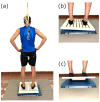Validity and reliability of an unstable board for dynamic balance assessment in young adults
- PMID: 36608060
- PMCID: PMC9821791
- DOI: 10.1371/journal.pone.0280057
Validity and reliability of an unstable board for dynamic balance assessment in young adults
Abstract
Scientific literature is giving greater importance to dynamic balance in fall prevention. Recently, the validity and reliability of the most employed functional tests for dynamic balance assessment has been investigated. Although these functional tests are practical and require minimal equipment, they are inherently subjective, as most do not use instrumented measurement data in the scoring process. Therefore, this study aimed to assess the validity and reliability of an instrumented unstable board for dynamic balance objective assessment in young adults through double-leg standing trials. A test-retest design was outlined with the unstable board positioned over a force platform to collect objective Center of Pressure (CoP) related and kinematic parameters. Fifteen young adults participated in two evaluation sessions (7-day apart) that comprised ten trials per two dynamic conditions (anterior-posterior and medio-lateral oscillations) aiming to maintain the board parallel to the ground. Pearson's correlation coefficient (r) was employed to assess the validity of the kinematic parameters with those derived from the CoP. The test-retest reliability was investigated through Intraclass Correlation Coefficient (ICC), Standard Error of the measurement, Minimal Detectable Change, and Bland-Altman plots. Statistically significant correlations between the CoP and kinematic parameters were found, with r values ranging from 0.66 to 0.95. Good to excellent intrasession (0.89≤ICCs≤0.95) and intersession (0.66≤ICCs≤0.95) ICCs were found for the kinematics parameters. The Bland-Altman plots showed no significant systematic bias. The kinematics parameters derived from the unstable board resulted valid and reliable. The small size of the board makes it a suitable tool for the on-site dynamic balance assessment and a complement of computerized dynamic posturography.
Copyright: © 2023 Rizzato et al. This is an open access article distributed under the terms of the Creative Commons Attribution License, which permits unrestricted use, distribution, and reproduction in any medium, provided the original author and source are credited.
Conflict of interest statement
The authors have declared that no competing interests exist.
Figures



References
-
- Takakusaki K, Takahashi M, Obara K, Chiba R. Neural substrates involved in the control of posture. Adv Robot. 2017;31: 2–23. doi: 10.1080/01691864.2016.1252690 - DOI
-
- Ulfiana E, Dewi TP, Yusuf A. The effect of balance exercise on postural balance of elderly as fall prevention in institutionalized elderly. Indian J Public Heal Res Dev. 2019;10: 2708–2712. doi: 10.5958/0976-5506.2019.02279.4 - DOI
MeSH terms
LinkOut - more resources
Full Text Sources

